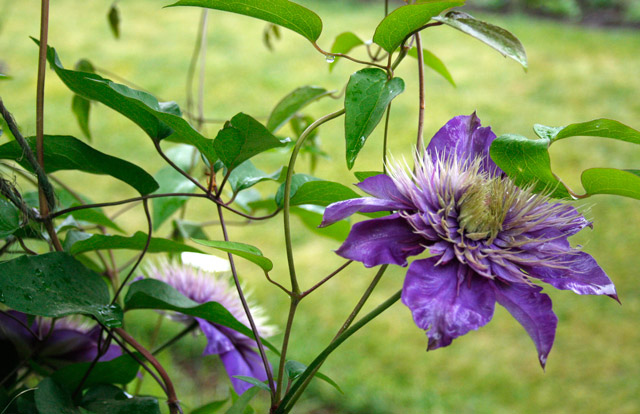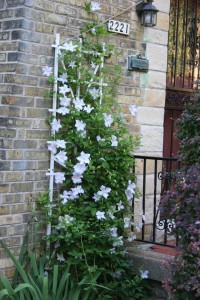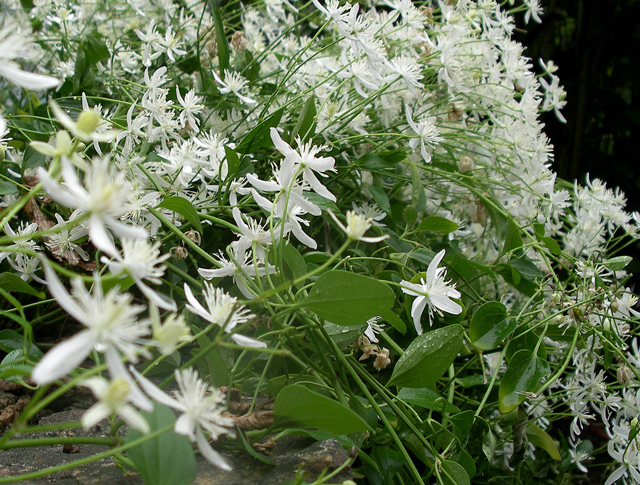 Multi-Blue Double Flowering Clematis
Multi-Blue Double Flowering Clematis
Clematis are one of my absolute faves when it comes to the summer garden — I know, I have a lot of them but no one ever said there was a limit, right? Fantastic color and profuse blooms, this perennial vine has so many uses and applications, just about everyone has a place for one. Everyone, however, does not necessarily know how to get them to flourish. I’ll quickly touch on two important aspects of a growing a clematis which may help you in your future endeavors:
 Watering: I would definitely place clematis in the “easy-to-grow” category — especially when planted in the right location. In my personal opinion, the key to successfully growing clematis all lies in the amount of moisture one receives. Sure, the right amount of sunlight (most thrive in an area that receives at least 6 hours of sun per day in the peak of the summer) is imperative for achieving the profuse blooms which a clematis can provide but receiving adequate watering is paramount to the overall health of the vine.
Watering: I would definitely place clematis in the “easy-to-grow” category — especially when planted in the right location. In my personal opinion, the key to successfully growing clematis all lies in the amount of moisture one receives. Sure, the right amount of sunlight (most thrive in an area that receives at least 6 hours of sun per day in the peak of the summer) is imperative for achieving the profuse blooms which a clematis can provide but receiving adequate watering is paramount to the overall health of the vine.
In the world of horticulture, we call it “wet feet” — basically a cool, somewhat moist environment at the bottom of the plant. Plant them near the base of smaller trees and shrubs and they will be extremely happy! If you have an area of your yard where the root system of the vine will be under some dappled shade but strong sunlight will still be allowed to reach the foliage and blooms, you’ve found the perfect spot. If not, create your own shade by lightly laying stones or planting annuals around the base. Also, be sure to provide adequate supplemental watering during extremely dry summer spells, even once established. Clematis roots extend deep into the soil so be sure to be thorough. For these reasons, I recommend planting a clematis nearer your residence, as opposed to way off along the back fence line or remote corner of your yard — you’ll want to have easy access.
Pruning: One of the most common questions I receive regarding clematis is whether or not they should be cut back and if so, when and how much. The tough thing about the answer to this question is that it largely depends on the specific variety of clematis you are growing. Clematis are generally categorized in three groups based on whether or not they bloom on old or new wood. Clematis which bloom only on old wood (Group I and also the smallest group), should only be pruned light after flowering to control size and remove dead wood. Group II Clematis (such as Multi-Blue Double Flowering, Carnival, Henryi, Ramona and Proteus Double Flowering) flower first on old and then again on new wood and therefore, can be pruned lightly in early spring to improve overall habit and remove dead or weak branches or immediately after the blooms have faded. Finally, Group III Clematis (such as Comtesse de Bouchaud, Jackmanii, Fairydust, Plena, Ernest Markham and Sweet Autumn) flower only on new wood and therefore, can be cut back within 12 inches of the ground in early spring.
Sweet Autumn Clematis
Ernest Markham Clematis
Now the question is: which type to do you have? Number one thing to keep in mind is that when purchasing a new clematis, be sure and read the information that comes with it. It will most likely be listed there! If not, head to cyberspace and do a search — chances are you’ll find it somewhere! Although not exhaustive, I found a very helpful listing here, provided by Devan Greenhouses, Ltd. Looks like a great place to visit should I ever get to British Columbia, Canada!
So add some charming climbers to your garden this year with clematis — you won’t be sorry you did!




